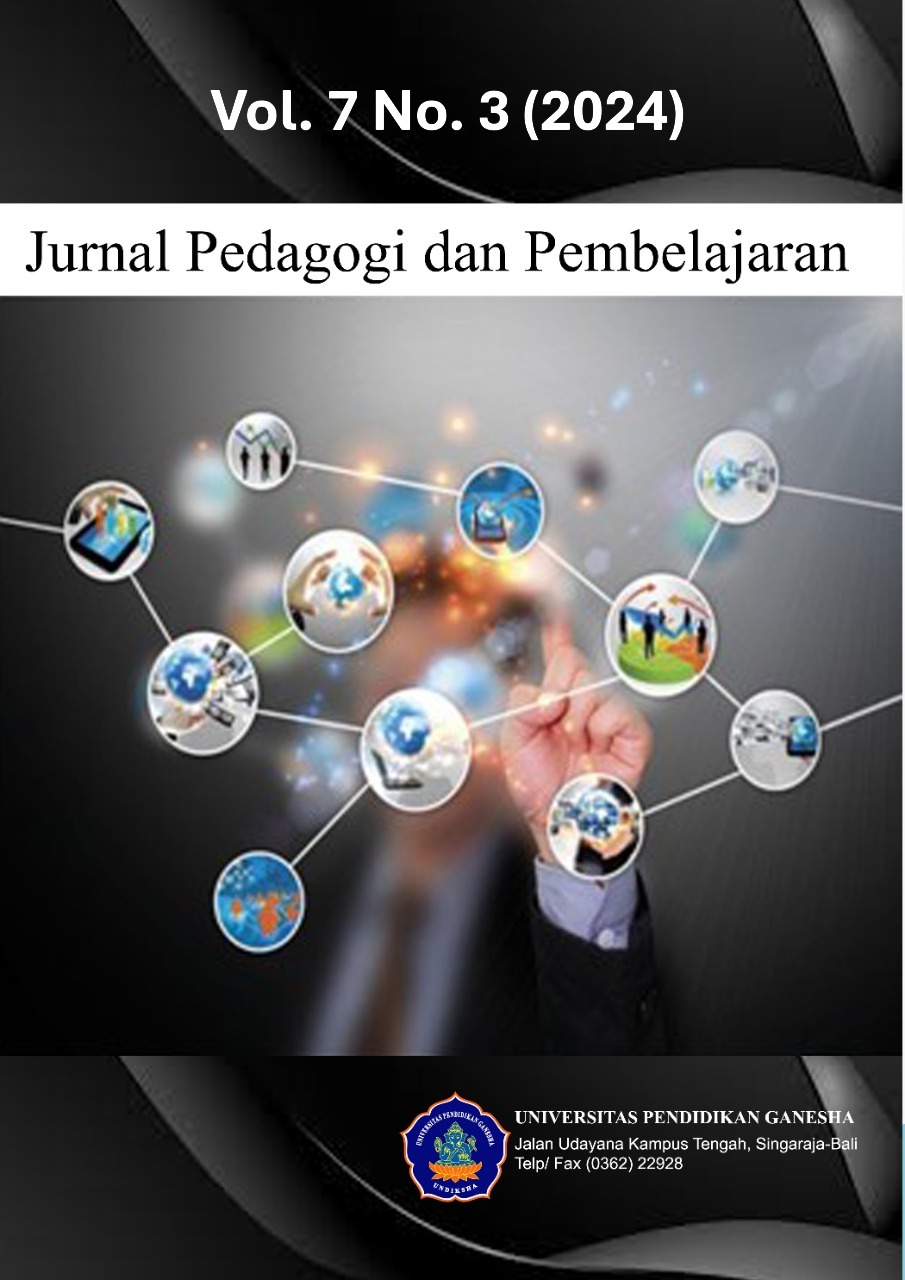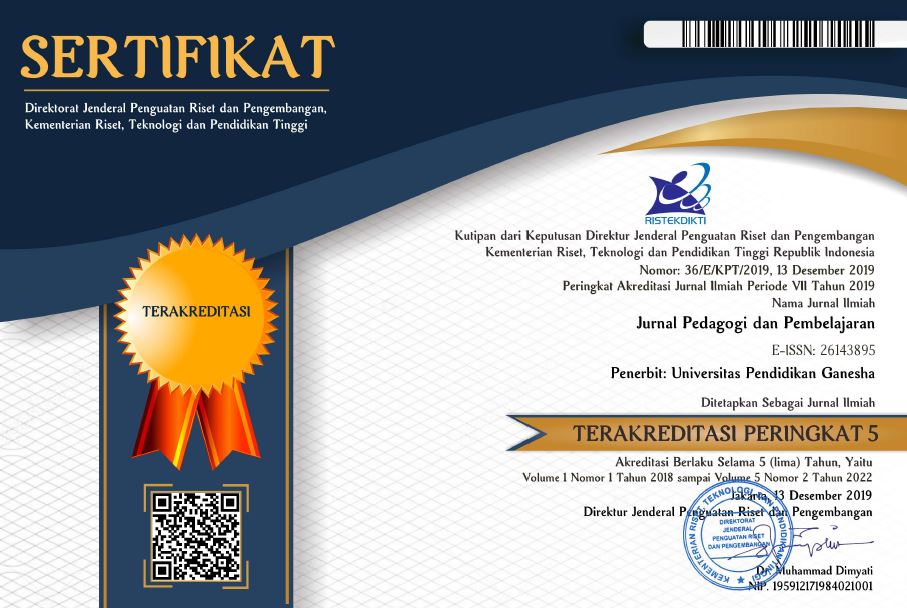Analyzing Parental Perceptions of Smartphone Usage in Early Childhood: Educational Potential and Risk Management
DOI:
https://doi.org/10.23887/jp2.v7i3.90470Keywords:
Early Childhood, Parents’ Perception, SmartphonesAbstract
Smartphone usage has significantly increased across various age groups, including early childhood. This phenomenon presents both concerns and opportunities for parents to utilize technology as a medium for stimulating children’s development. This study aims to explore parents' perceptions of the benefits and negative impacts of smartphone usage for young children and to analyze differences in perceptions based on parents' demographic characteristics. The research employs a descriptive quantitative approach with a comparative analysis. The sampling technique used is stratified random sampling, involving 197 parents of kindergarten children aged 3-6 years as respondents. Data were collected through a Likert-scale questionnaire distributed online via Google Forms. The analysis results indicate that 65% of parents perceive smartphones as beneficial educational tools for supporting children's cognitive development. However, 60% of parents express concerns about the negative impacts of smartphone usage, particularly on children's social-emotional and motor development. The findings also reveal that parents with higher education levels are more focused on controlling smartphone usage risks by setting time limits and content restrictions, while parents with middle-level education tend to emphasize the entertainment benefits of smartphones for children. The study concludes that strict supervision of smartphone usage in early childhood is necessary to minimize negative impacts and maximize its educational benefits.
References
Al Hosani, S. S., Darwish, E. A., Ayanikalath, S., AlMazroei, R. S., AlMaashari, R. S., & Wedyan, A. T. (2023). Screen time and speech and language delay in children aged 12–48 months in UAE: a case–control study. Middle East Current Psychiatry, 30(1). https://doi.org/10.1186/s43045-023-00318-0 DOI: https://doi.org/10.1186/s43045-023-00318-0
Amalia, S., & Setyowati, S. (2019). Persepsi Orang Tua Terhadap Penggunaan Gadget Pada Anak Usia Dini Di Tk Surabaya. PG PAUD Universitas Negeri Surabaya. https://ejournal.unesa.ac.id/index.php/paud-teratai/article/view/27946/25568
Andriani, J. (2023). The Influence Of Smartphones On Child Development: A Psychological And Educational Analysis. Jurnal Ikhtibar Nusantara Vol, 1(333), 149–160. https://doi.org/10.62901/j-ikhsan.v3i2.137 DOI: https://doi.org/10.62901/j-ikhsan.v1i2.18
Ardiyani, I. D., Setiawati, Y., & Hsieh, Y.-T. (2021). Education For Parents Of Children With Gadget Addiction. Jurnal Berkala Epidemiologi, 9(3), 221–230. https://doi.org/10.20473/jbe.v9i32021.221 DOI: https://doi.org/10.20473/jbe.V9I32021.221-230
Aswadi, D., & Lismayanti, H. (2019). Dampak Penggunaan Smartphone terhadap Pendidikan Karakter Anak di Era Milenial. STILISTIKA: Jurnal Bahasa, Sastra, Dan Pengajarannya, 4(1), 89–98. https://doi.org/10.33654/sti.v4i1.970 DOI: https://doi.org/10.33654/sti.v4i1.970
Axelsson, E. L., Purcell, K., Asis, A., Paech, G., Metse, A., Murphy, D., & Robson, A. (2022). Preschoolers’ engagement with screen content and associations with sleep and cognitive development. Acta Psychologica, 230(March), 103762. https://doi.org/10.1016/j.actpsy.2022.103762 DOI: https://doi.org/10.1016/j.actpsy.2022.103762
Bangsawan, I., Ridwan, R., & Fauziyah, N. (2022). Pengaruh Gadget Terhadap Perkembangan Kognitif Anak Usia Dini. Jurnal Pendidikan Anak, 8(1), 31–39. https://doi.org/10.23960/jpa.v8n1.24067 DOI: https://doi.org/10.23960/jpa.v8n1.24067
Braveman, P. A., Cubbin, C., Egerter, S., Chideya, S., Marchi, K. S., Metzler, M., & Posner, S. (2005). Socioeconomic Status in Health Research. Jama, 294(22), 2879.
https://doi.org/10.1001/jama.294.22.2879 DOI: https://doi.org/10.1001/jama.294.22.2879
Cho, K. S., & Lee, J. M. (2017). Influence of smartphone addiction proneness of young children on problematic behaviors and emotional intelligence: Mediating self-assessment effects of parents using smartphones. Computers in Human Behavior, 66, 303–311.
https://doi.org/10.1016/j.chb.2016.09.063 DOI: https://doi.org/10.1016/j.chb.2016.09.063
Chusna, P. A. (2017). Pengaruh Media Gadget Pada Perkembangan Karakter Anak. Dinamika Penelitian: Media Komunikasi Sosial Keagamaan, vol 17(no 2), 318.
https://doi.org/10.21274/dinamika.2017.17.2.315-330
Ewin, C. A., Reupert, A., McLean, L. A., & Ewin, C. J. (2021). Mobile devices compared to non-digital toy play: The impact of activity type on the quality and quantity of parent language. Computers in Human Behavior, 118(November 2020), 106669. https://doi.org/10.1016/j.chb.2020.106669 DOI: https://doi.org/10.1016/j.chb.2020.106669
Fernald, L. C. H., Prado, E., Kariger, P., & Raikes, A. (2017). A Toolkit for Measuring Early Childhood Development in Low- and Middle-Income Countries. International Bank for Reconstruction and Development/The World Bank. The Strategic Impact Evaluation Fund, the World Bank. https://hdl.handle.net/20.500.12799/5723 DOI: https://doi.org/10.1596/29000
Genc, Z. (2014). Parents’ Perceptions about the Mobile Technology Use of Preschool Aged Children. Procedia - Social and Behavioral Sciences, 146, 55–60. https://doi.org/10.1016/j.sbspro.2014.08.086 DOI: https://doi.org/10.1016/j.sbspro.2014.08.086
Ghofururrohim, N. M., Wicaksono, R. N., & Faristiana, A. R. (2023). Pengaruh Smartphone Terhadap Anak Usia Dini. Education : Jurnal Sosial Humaniora Dan Pendidikan, 3(2), 129–146.
https://doi.org/10.51903/education.v3i2.340 DOI: https://doi.org/10.51903/education.v3i2.340
Gür, D., & Türel, Y. K. (2022). Parenting in the digital age: Attitudes, controls and limitations regarding children’s use of ICT. Computers and Education, 183(February), 104504.
https://doi.org/10.1016/j.compedu.2022.104504 DOI: https://doi.org/10.1016/j.compedu.2022.104504
Herodotou, C. (2018). Young children and tablets: A systematic review of effects on learning and development. Journal of Computer Assisted Learning, 34(1), 1–9.
https://doi.org/10.1111/jcal.12220 DOI: https://doi.org/10.1111/jcal.12220
Hiniker, A., Suh, H., Cao, S., & Kientz, J. A. (2016). Screen Time Tantrums. The 2016 CHI Conference on Human Factors in Computing Systems, 648–660. https://doi.org/10.1145/2858036.2858278 DOI: https://doi.org/10.1145/2858036.2858278
Hinkley, T., & McCann, J. R. (2018). Mothers’ and father’s perceptions of the risks and benefits of screen time and physical activity during early childhood: A qualitative study. BMC Public Health, 18(1), 1–8. https://doi.org/10.1186/s12889-018-6199-6 DOI: https://doi.org/10.1186/s12889-018-6199-6
Huber, B., Tarasuik, J., Antoniou, M. N., Garrett, C., Bowe, S. J., & Kaufman, J. (2016). Young children’s transfer of learning from a touchscreen device. Computers in Human Behavior, 56, 56–64. https://doi.org/10.1016/j.chb.2015.11.010 DOI: https://doi.org/10.1016/j.chb.2015.11.010
Hutton, J. S., Dudley, J., Horowitz-Kraus, T., Dewitt, T., & Holland, S. K. (2020). Associations between Screen-Based Media Use and Brain White Matter Integrity in Preschool-Aged Children. JAMA Pediatrics, 174(1), 1–10. https://doi.org/10.1001/jamapediatrics.2019.3869 DOI: https://doi.org/10.1001/jamapediatrics.2019.3869
Indriyani, M., Sofia, A., & Anggraini, G. F. (2018). Persepsi Orang Tua terhadap Penggunaan Gadget pada Anak Usia Dini. INDONESIAN JOURNAL OF EARLY CHILDHOOD ISSUES, 1(1). https://jurnal.fkip.unila.ac.id/index.php/IJECI/article/view/16887/12048
Jiménez-Morales, M., Montaña, M., & Medina-Bravo, P. (2020). Childhood use of mobile devices: Influence of mothers’ socio-educational level. Comunicar, 28(64), 19–26. https://doi.org/10.3916/C64-2020-02 DOI: https://doi.org/10.3916/C64-2020-02
Johnson, G. M. (2011). Self-Esteem and Use of the Internet among Young. International Journal of Psychological Studies, 3(2), 48–53. https://doi.org/10.5539/ijps.v3n2p48 DOI: https://doi.org/10.5539/ijps.v3n2p48
Kazakoff, E. R. (2014). Toward a theory-predicated definition of digital literacy for early childhood. Journal of Youth Development, 9(1), 41–58. https://doi.org/10.5195/jyd.2014.71 DOI: https://doi.org/10.5195/jyd.2014.71
Liu, W., Wu, X., Huang, K., Yan, S., Ma, L., Cao, H., Gan, H., & Tao, F. (2021). Early childhood screen time as a predictor of emotional and behavioral problems in children at 4 years: a birth cohort study in China. Environmental Health and Preventive Medicine, 26(1), 1–9. https://doi.org/10.1186/s12199-020-00926-w DOI: https://doi.org/10.1186/s12199-020-00926-w
Livingstone, S. (2003). Children’s use of the Internet: Reflections on the emerging research agenda. New Media and Society, 5(2), 147–166. https://doi.org/10.1177/1461444803005002001 DOI: https://doi.org/10.1177/1461444803005002001
Livingstone, S., & Helsper, E. J. (2008). Parental mediation of children’s internet use. Journal of Broadcasting and Electronic Media, 52(4), 581–599. https://doi.org/10.1080/08838150802437396 DOI: https://doi.org/10.1080/08838150802437396
Lubis, H., Rosyida, A. H., & Solikhatin, N. H. (2019). Pola Asuh Efektif Di Era Digital. PLAKAT (Pelayanan Kepada Masyarakat), 1(2), 102. https://doi.org/10.30872/plakat.v1i2.2967 DOI: https://doi.org/10.30872/plakat.v1i2.2967
Mantziki, K., Renders, C. M., Vassilopoulos, A., Radulian, G., Borys, J., Plessis, H., Gregório, M. J., Graça, P., Henauw, S. De, Handjiev, S., Visscher, T. L. S., & Seidell, J. C. (2016). Inequalities in energy-balance related behaviours and family environmental determinants in European children : changes and sustainability within the EPHE evaluation study. International Journal for Equity in Health, 1–13. https://doi.org/10.1186/s12939-016-0438-1 DOI: https://doi.org/10.1186/s12939-016-0438-1
Marsh, J., Plowman, L., Yamada-Rice, D., Bishop, J., Lahmar, J., & Scott, F. (2018). Play and creativity in young children’s use of apps. British Journal of Educational Technology, 49(5), 870–882. https://doi.org/10.1111/bjet.12622 DOI: https://doi.org/10.1111/bjet.12622
Mayuni, R., & Amanda, S. T. (2023). The Influence Of Gadgets In Student Learning Development. International Journal of Students Education, 1(2), 151–157.
https://doi.org/10.62966/ijose.v1i2.399
Moon, J. H., Cho, S. Y., Lim, S. M., Roh, J. H., Koh, M. S., Kim, Y. J., & Nam, E. (2019). Smart device usage in early childhood is differentially associated with fine motor and language development. Acta Paediatrica, International Journal of Paediatrics, 108(5), 903–910. https://doi.org/10.1111/apa.14623 DOI: https://doi.org/10.1111/apa.14623
Mutlu-Bayraktar, D., Yılmaz, Ö., & İnan-Kaya, G. (2018). Digital Parenting: Perceptions on Digital Risks. Kalem Uluslararasi Egitim ve Insan Bilimleri Dergisi, 14(1), 137–163.
https://doi.org/10.23863/kalem.2018.96 DOI: https://doi.org/10.23863/kalem.2018.96
Nelissen, S., & Van den Bulck, J. (2018). When digital natives instruct digital immigrants: active guidance of parental media use by children and conflict in the family. Information Communication and Society, 21(3), 375–387. https://doi.org/10.1080/1369118X.2017.1281993 DOI: https://doi.org/10.1080/1369118X.2017.1281993
Paridawati, I., Daulay, M. I., & Amalia, R. (2021). Persepsi Orangtua Terhadap Penggunaan Smartphone pada Anak Usia Dini di Desa Indrasakti Kecamatan Tapung Kabupaten Kampar. Journal Of Teacher Education, 2(2), 28–34. https://doi.org/10.3100/jote.v2i2.1329
Rahayu, N. S., Elan, E., & Mulyadi, S. (2021). Analisis penggunaan gadget pada anak usia dini. Jurnal PAUD Agapedia, 5(2), 202–210. https://doi.org/10.17509/jpa.v5i2.40743 DOI: https://doi.org/10.17509/jpa.v5i2.40743
Saraswati, S. W. E., Setiawan, D., & Hilyana, F. S. (2021). Dampak Penggunaan Smartphone pada Perilaku Anak Di Desa Muktiharjo Kabupaten Pati. WASIS : Jurnal Ilmiah Pendidikan, 2(2), 96–102. https://doi.org/10.24176/wasis.v2i2.6432 DOI: https://doi.org/10.24176/wasis.v2i2.6432
Shukri, S. R. M., & Howes, A. (2019). Children adapt drawing actions to their own motor variability and to the motivational context of action. International Journal of Human Computer Studies, 130, 152–165. https://doi.org/10.1016/j.ijhcs.2019.06.004 DOI: https://doi.org/10.1016/j.ijhcs.2019.06.004
Srinahyanti, S., Wau, Y., Manurung, I., & Arjani, N. (2019). Influence of Gadget: A Positive and Negative Impact of Smartphone Usage for Early Child. ACEIVE. https://doi.org/10.4108/eai.3-11-2018.2285692 DOI: https://doi.org/10.4108/eai.3-11-2018.2285692
Supanitayanon, S., Trairatvorakul, P., & Chonchaiya, W. (2020). Screen media exposure in the first 2 years of life and preschool cognitive development: a longitudinal study. Pediatric Research, 88(6), 894–902. https://doi.org/10.1038/s41390-020-0831-8 DOI: https://doi.org/10.1038/s41390-020-0831-8
Swider-Cios, E., Vermeij, A., & Sitskoorn, M. M. (2023). Young children and screen-based media: The impact on cognitive and socioemotional development and the importance of parental mediation. Cognitive Development, 66(February), 101319. https://doi.org/10.1016/j.cogdev.2023.101319 DOI: https://doi.org/10.1016/j.cogdev.2023.101319
Tigor, M., & Simbolon, A. P. H. (2023). The Impact of Smartphone Use on Students’ Motor Skills and Emotional Well-being: A Comprehensive Study. Jurnal Ilmu Pendidikan Dan Humaniora, 12(3), 152–166. https://doi.org/10.35335/jiph.v12i3.8 DOI: https://doi.org/10.35335/jiph.v12i3.8
TRINIKA, Y. (2015). Pengaruh Penggunaan Gadget Terhadap Perkembangan Psikososial Anak Usia Prasekolah (3-6 Tahun) di TK Swasta Kristen Immanuel Tahun Ajaran 2014-2015. Jurnal ProNers, 3(1). https://doi.org/10.26418/jpn.v3i1.11001
Valkenburg, P. M., & Karen E, S. (2001). Children’s Positive and Negative Experiences With the Internet: An Exploratory Survey. Communication Research, 28(5), 652–675.
https://doi.org/10.1177/009365001028005004 DOI: https://doi.org/10.1177/009365001028005004
Valkenburg, P. M., Piotrowski, J. T., & Hermanns, J. (2012). Developing and validating the perceived parental media mediation scale : A self-determination perspective. Learning, Media & Technology, 39, 445–469. https://doi.org/10.1111/hcre.12010 DOI: https://doi.org/10.1111/hcre.12010
Yadav, S., & Chakraborty, P. (2022). Child–smartphone interaction: relevance and positive and negative implications. Universal Access in the Information Society, 21(3), 573–586.
https://doi.org/10.1007/s10209-021-00807-1 DOI: https://doi.org/10.1007/s10209-021-00807-1
Zaini, M., & Soenarto, S. (2019). Persepsi Orangtua Terhadap Hadirnya Era Teknologi Digital di Kalangan Anak Usia Dini. Jurnal Obsesi : Jurnal Pendidikan Anak Usia Dini, 3(1), 254.
https://doi.org/10.31004/obsesi.v3i1.127. DOI: https://doi.org/10.31004/obsesi.v3i1.127
Downloads
Published
How to Cite
Issue
Section
License
Copyright (c) 2024 Desni Yuniarni, Endang R. Surjaningrum, Triana Kesuma Dewi

This work is licensed under a Creative Commons Attribution-ShareAlike 4.0 International License.
Authors who publish with Jurnal Pedagogi dan Pembelajaran agree to the following terms:
- Authors retain copyright and grant the journal the right of first publication with the work simultaneously licensed under a Attribution-ShareAlike 4.0 International (CC BY-SA 4.0) that allows others to share the work with an acknowledgment of the work's authorship and initial publication in this journal
- Authors are able to enter into separate, additional contractual arrangements for the non-exclusive distribution of the journal's published version of the work (e.g., post it to an institutional repository or publish it in a book), with an acknowledgment of its initial publication in this journal.
- Authors are permitted and encouraged to post their work online (e.g., in institutional repositories or on their website) prior to and during the submission process, as it can lead to productive exchanges, as well as earlier and greater citation of published work. (See The Effect of Open Access)











